Propeller, hydrofoil and foil Cavitation
Understand and master the propellers and hydrofoils Cavitation:
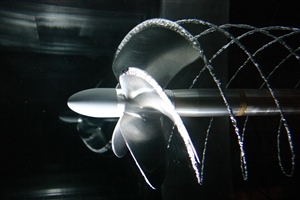
(VEEM propellers evaluation in a cavitation testing tunnel showing the formation of stable sheet cavitation on the low-pressure side of the blade).
Cavitation is primarily an ebullition of water:
When the ambient pressure becomes lower than the saturated vapor pressure appears cavitation. Cavitation can be caused by a warming of the water or by a pressure drop. Cavitation observed on propellers or hydrofoils is mainly caused by the pressure drop of water in areas where localized pressure drop is observed.
- The saturation vapor pressure of water at 0 degrees is 0.006 bars(600 pascals 1 pascal=1newtons applied to 1m²) and 0.013 bars(1300 pascals) at 10 degrees. Cavitation appears more easily in hot water than in cold water.
- The depth of immersion of the propeller generates the static pressure and pushes the cavitation limit by increasing the pressure of the environment. A propeller in depth water cavitate less rapidly that a propeller near surface:
Viewing the surface pressure of marine turbine in the software Heliciel: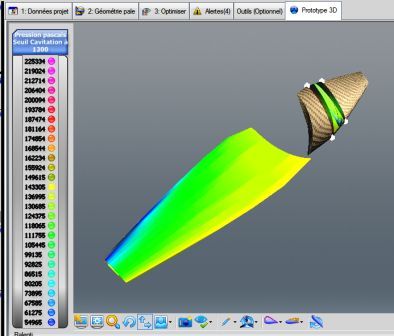
- Increase the application surface of the lift force.
- increasing diameter of the propeller.
- increasing chord width of the blades.
- distributing lift on a maximum surface, using the profile shape determining the position of the point of application of lift
- increasing the number of blades.
- Decrease lift.
- decreasing incidence (attack) angles.
- decreasing the rotational speed.
- Increase the depth of immersion (depth is entered in optimize tab) to increase the static pressure of the environment..
- Reduce the temperature of the liquid. (for change the temperature of the liquid and therefore the limit of cavitation click edit fluid in the "Project / fluid data" tab and select the temperature)
Detailed results of pressure distribution of the blades elements in heliciel software

- Two main sources of pressure drop may create cavitation can be generated by our blade:
- The lift applied to the upper surface is the result of the vacuum created by the profile shape. If this depression reduces the ambient pressure below the saturation vapor pressure, the blade cavite. This cavitation forms a gas pocket which covers the maximum point of depression concentrated around the center of lift of the profile.
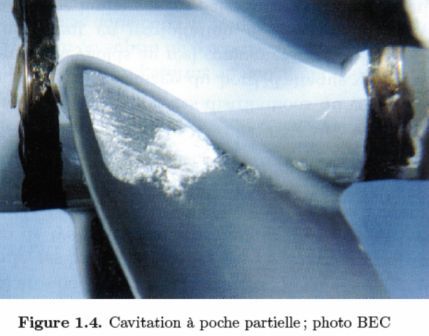 If left on the blade without localized beyond the trailing edge, the lift is s' not necessarily collapse because depression of the pocket continues to suck the upper surface, but the elasticity gas pocket prevents the increase the lift as effectively as in the liquid. Any increase in lift will be transformed into gas expansion. It follows an increase in the volume of the pocket and its surface in contact with the upper surface. This increase in surface depression further increases lift, but when the surface of the pocket reaches the trailing edge and covers the entire width of the profile, the performance 's collapse. Some research leads to the conclusion that when the cavitation is moderate it can even increase performance because it reduces friction. But the constantly changing operating conditions propellers make this range very complex to master, and we will prefer not to risk a total loss of performance, so we keeping our propeller as far as possible from the cavitation zone.
If left on the blade without localized beyond the trailing edge, the lift is s' not necessarily collapse because depression of the pocket continues to suck the upper surface, but the elasticity gas pocket prevents the increase the lift as effectively as in the liquid. Any increase in lift will be transformed into gas expansion. It follows an increase in the volume of the pocket and its surface in contact with the upper surface. This increase in surface depression further increases lift, but when the surface of the pocket reaches the trailing edge and covers the entire width of the profile, the performance 's collapse. Some research leads to the conclusion that when the cavitation is moderate it can even increase performance because it reduces friction. But the constantly changing operating conditions propellers make this range very complex to master, and we will prefer not to risk a total loss of performance, so we keeping our propeller as far as possible from the cavitation zone. - The drag of the profile can generate a negative pressure, shown on the rear of the profile. If streaks applies over an area equivalent to the frontal surface (super cavitating profiles). this lowers the ambient pressure below the saturated vapor pressure, and the blade may cavitate.
- Depression concentrated (lift applied symmetrically around the point of lift)
- Depression distributed over the surface (lift applied over the entire surface)
- Depression drag applied on an area equal to the front surface
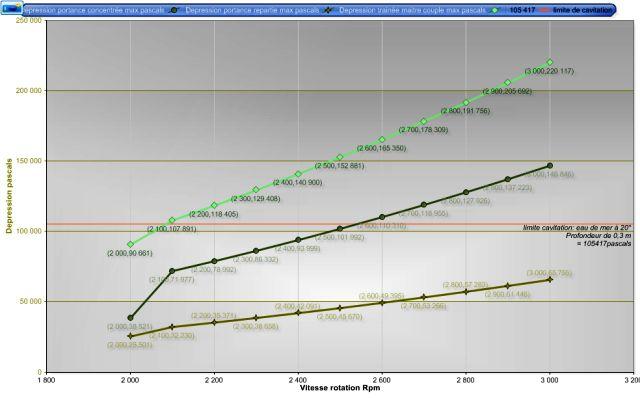

the lift applied to the surface of the upper surface of blade gives us the depression due to the lift. But as we have seen earlier, this lift is not uniformly applied on the upper surface, in fact, the point of application of the lift on the profiles is usually located around 0.25 times the profile chord starting from the leading edge.(Heliciel software uses data profiles to find the point of lift).extract from the database HELICIEL
Depression is concentrated around the point of lift. We can roughly estimate that the depression will be equal to the lift applied symmetrically around the point of lift. For a point lift at 0.25 times the rope: 0.25 front and 0.25 rear, which reduce the surface action 0.5 times the upper surface of the lift if the point is 0.25 times the rope. Depression will be max: Depression = (Lift force N) / (0.5 X surface_extrados). If the point of application of the lift of the profile is located at of the leading edge 0.35, héliciel considers that the suction zone is concentrated (0.35 X 2) = 0.7 times the area of the upper surface. We just imagine that a profile generating its lift closest to the center of the rope, (0.5) distribute its lift on the entire surface of the upper, so the depression will be low. Profiles with a lift point near the center are less prone to cavitation!
- How to recognize a profile with a centered point lift? The incidence of profile plays a role in the position of the lift, but we will leave aside for us just interested in the shape of the profile and guess where will locate the point of lift:
- theory speaks of the speed variation due to differences in path lengths between the intrados and extrados. This difference in path lengths would force the fluid to accelerate, driven by the viscosity and the contact of the particles surrounding fluid. Without diving into too much theory, Bernoulli enlightened us in giving the law of conservation of energy in the fluid. The sum of the energy and kinetic pressure is constant for a given volume of fluid. Other words if the fluid accelerates, the energy in the acceleration will be taken to its pressure (fluid pressure decreases) If the fluid slows energy removed e of the speed by slowing will be added to its pressure (the fluid pressure increases). The acceleration on the upper surface (the longest path) and the slowdown in the underside (shortest path) would therefore causes the pressure on the underside and depression on upper.
- The phenomenon of change of momentum,generates by the change of direction of the fluid imposed by the meeting of the rest of the profile explained lift forces. It seems that this explanation is more realistic.
In any case, one thing is certain is that a vacuum is generated on the upper surface and pressure is generated on the underside. (If the angle of incidence generates lift). The fact is that the lift is concentrated in the area between the edge (just after) and the point where the fluid is no longer forced to change direction. The area where the fluid is no longer obliged to change direction, it is the area of maximum thickness if the incidence (attack angle) is zero.
Cavitation is a complex topic that is approached only superficially on this page. For further reading I invite you to consult the thesis on cavitation from Mr Surasak PHOEMSAPTHAWEE which is in my humble opinion a useful reference.
The suction zone is distributed, from leading edge (next) to the point where the upper surface is parallel to the fluid stream. The lift point is in the middle of this area. The cavitation zone is therefore around the point of lift:
In the curve of lift coefficient on a profile in the software Heliciel (below), The pink curve shows the distribution of depression on the upper surface. Point 0 of the x-axis corresponds to the leading edge and point 1 corresponds to the trailing edge. The blue curve represents the intrados. (The y-axis is reversed: positive values under the x-axis)
If one angle of incidence is given to the profile, the point where the suction becomes parallel to the fluid, approaches of the leading edge and reduces the area where the lift is concentrated. Thus depression focuses and cavitation will appear more e
asily. If you look at a profile, and its upper surface, you know that the point of lift is approximately halfway between the leading edge and the area parallel to the flow:
.
More the area of max thickness is moved back, the more particles continue to accelerate a long time, thus distributing their area of depression over a larger area. The same lift force spread over a large surface generates less depression concentrated. Profiles of the propeller blades operating in the water should have a max thickness rearmost possible so as not cavitate too soon.Below is a profile lift of high concentration that might cavitate easily :
Below is a profile of low concentration but the rear lift may generate a lot of drag because of its thickness! This profile may be not cavitate because of the lift but because of its drag.
Below is a profile which spread the best its lift without creating too much drag:
These forms are taken as an example and are not qualified for a propeller Here is a more classic marine profile

(extracted from the database Heliciel software):
Répartion de portance d'un profil dans Heliciel . Forme classique de profil aérien(extrait de la base de données héliciel):
Photo of a foil with a thickness max on the rear distributing its lift. better than the rudder (vertical) which supports it. It is a good example of the importance of the choice of profiles
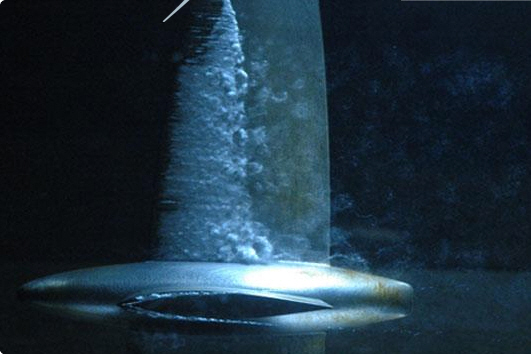

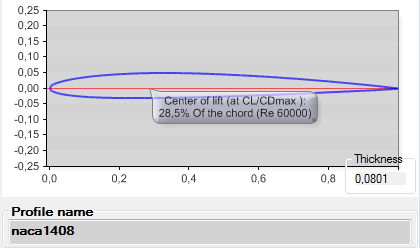
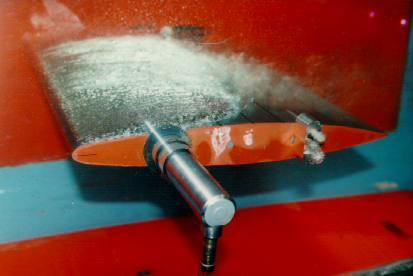
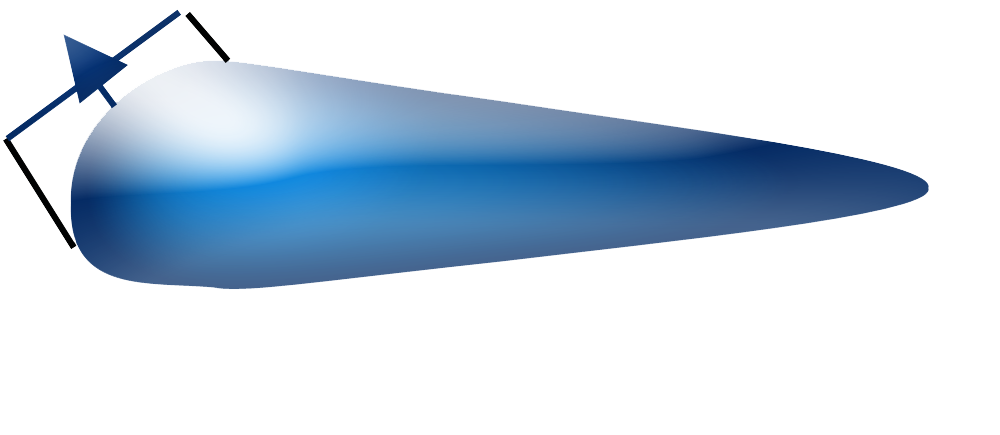

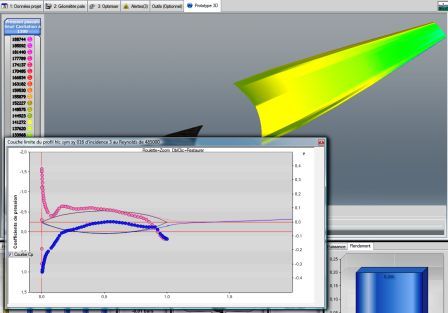
 Global site map
Global site map Mecaflux
Mecaflux Tutorials Mecaflux Pro3D
Tutorials Mecaflux Pro3D Tutorials Heliciel
Tutorials Heliciel Mecaflux Store
Mecaflux Store Compare software functions
Compare software functions Quotes, Orders, Payment Methods
Quotes, Orders, Payment Methods project technical studies
project technical studies